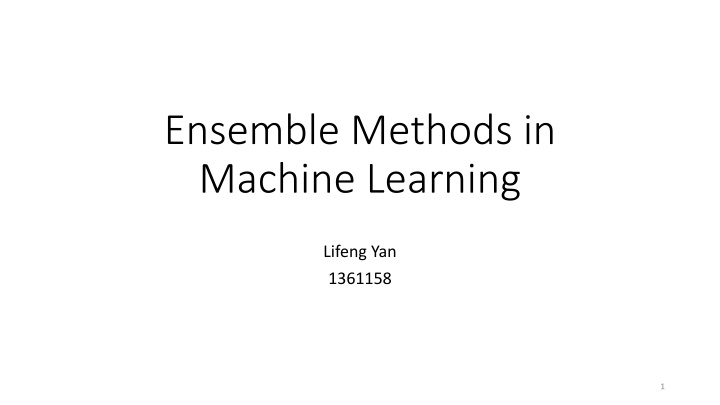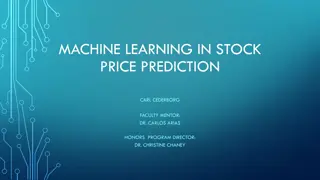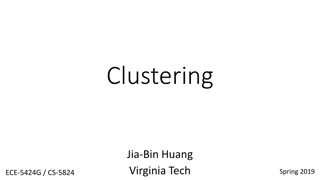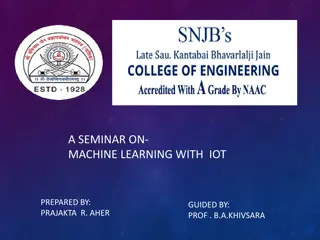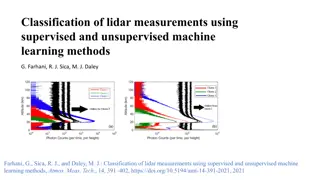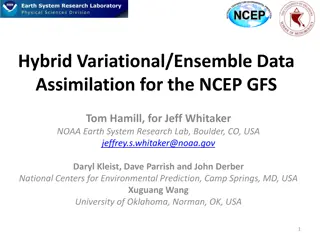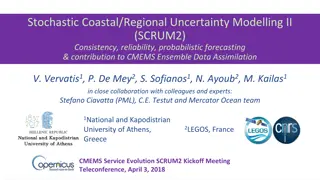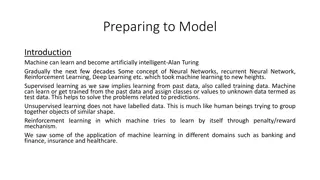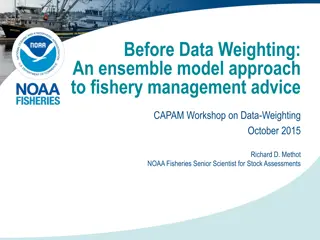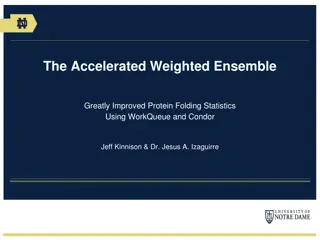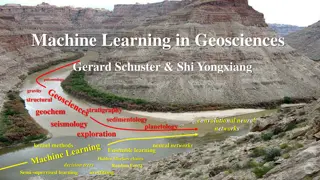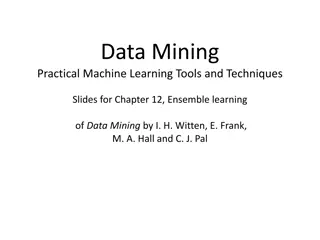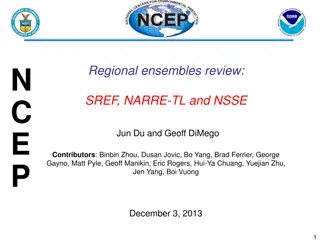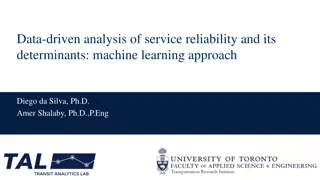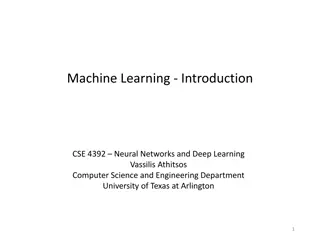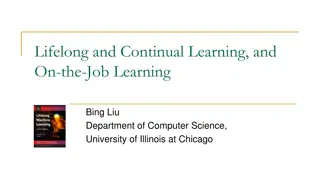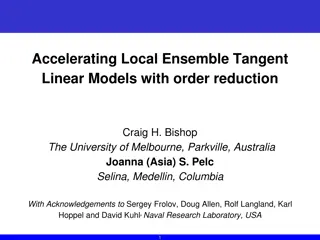Ensemble Methods in Machine Learning
Ensemble methods in machine learning involve combining multiple classifiers to improve accuracy and diversity. By leveraging statistical, computational, and representational reasons, ensemble methods can effectively address the limitations of individual classifiers. Bayesian Voting is one such method that utilizes posterior probabilities to make predictions based on training samples and hypotheses.
Download Presentation

Please find below an Image/Link to download the presentation.
The content on the website is provided AS IS for your information and personal use only. It may not be sold, licensed, or shared on other websites without obtaining consent from the author.If you encounter any issues during the download, it is possible that the publisher has removed the file from their server.
You are allowed to download the files provided on this website for personal or commercial use, subject to the condition that they are used lawfully. All files are the property of their respective owners.
The content on the website is provided AS IS for your information and personal use only. It may not be sold, licensed, or shared on other websites without obtaining consent from the author.
E N D
Presentation Transcript
Ensemble Methods in Machine Learning Lifeng Yan 1361158 1
Ensemble of classifiers Given a set of training examples, a learning algorithm outputs a classifier which is an hypothesis about the true function f that generate label values y from input training samples x. Given new x values, the classifier predicts the corresponding y values. An ensemble of classifiers is a set of classifiers whose individual decisions are combined in some way (typically by weighted or unweighted voting) to classify new examples. Main discovery from some researches shows that ensembles are often much more accurate than the individual classifiers that make them up. 2
Make sure ensemble learning works A necessary and sufficient condition for an ensemble of classifiers is that the classifiers should be accurate and diverse. Accurate means better than random guessing, diverse means make different errors on new data inputs, or make uncorrelated errors. In theory, with hypothesis that are diverse and error rate over 0.5, error rate voting result of ensemble method will increase. So the classifiers should be accurate. But there in some version of adaboost algorithm, negative weights are given to those classifiers with accuracy less that 0.5 3
Why it works Three main reasons for why the ensemble method work: statistical, computational and representational reasons Statistical reason: A learning algorithm can be viewed as searching a space H of hypotheses to identify the best one in the space. The number of training samples available is small comparing to the size of hypotheses space, and as a result the learning algorithm could find different hypotheses(classifier) that all give out same accuracy. So the ensemble of these classifiers could average their votes and reduce the risk of choosing the wrong classifier. 4
Why it works Computational reason: Local search algorithms may be trapped in a local minima, and if there is enough training data, it is computationally hard to get the best hypotheses. For ensemble learning the local search could start from different points and may provide a better approximation than any of the individual ones. Representational reason: The true function f cannot be represented by any of the hypotheses in the space in most machine learning applications, but weighted sum of hypotheses drawn from the space may expand the space of representation functions. 5
Methods: Bayesian Voting The Bayesian voting method satisfy: ? ? ? = ? ?,? = ? ? ? ? where by Bayes rule ?( |?) ? ? ?( ) x is a new point, y is the predicted value, S is a training sample, h is the hypotheses that defines: ? = ? ? ? = ? ?, ,and weight of the hypotheses is the posterior probability ?( |?) So the in total the classifier can be expressed as follows: ? = ?????? ? ? ? = ? ?, ? ? ?( ) ? 6
Methods: Bayesian Voting When the training sample is small, many hypotheses will have significantly large posterior probabilities, and the voting process can average these to eliminate the remaining uncertainty. When the training sample is large, typically only one hypothesis has substantial posterior probability and the ensemble effectively shrinks to contain only a single hypothesis. Enumerating the hypotheses, could be optical theoretically, but not in practical, since the space H and prior belief P(h) are hard to decide 7
Methods: Manipulating the Training Examples The learning algorithm is run several times, each time with a different subset of the training examples, which works especially well for unstable algorithms. Bagging: training set is consisted of a sample of m training examples drawn randomly with replacement from the original training set of m items, which is called a bootstrap replicate of the original dataset. Cross-validated committees: divide the training set into k disjoint subsets, repeat dropping one of these k sets k times and get k overlapped training sets. 8
Methods: Manipulating the Training Examples Adaboost 9
Methods: Manipulating the Output Targets Error-correcting output coding: Useful when the number of classes K is large. Each class is encoded with a L-bit codeword, The ?? learned classifier attempts to predict bit ? of these codewords. When the L classifiers are applied to classify a new point x their predictions are combined into an L-bit string. Then class j with codeword closest to the output string is chosen as classification result. 10
Methods: Injecting Randomness In the backpropagation algorithm, the initial weights of the network are set randomly if the algorithm is applied to the same training examples but with different initial weights, the resulting classifier can be quite different. It also works with decision trees (e.g. C4.5): chooses randomly among the top best tests instead of top-ranked feature-value test during the key decision that choose a feature to test at each internal node. Works with FOIL, bootstrap sampling and Markov chain Monte Carlo methods, where posterior probability should be introduced as voting weight instead of uniform vote. 11
Comparison of different ensemble methods Without noise 20% artificial noise 12
Some explanation of the result Statistical: If large decision tree is needed, then large training dataset is needed, which can not be guaranteed. Computational: If a mistake is made while greedily searching the best (smallest) decision tree, then all subsequence are likely to be affected. So the C4.5 decision tree algorithm is not stable. Representational: a voted combination of small decision trees is equivalent to a much larger single tree so an ensemble method can construct a good approximation to a diagonal decision boundary using several small trees 13
Further analysis Bagging randomized trees, these two methods are acting somewhat like Bayesian voting: they are sampling from the space of all possible hypotheses with a bias toward hypotheses that give good accuracy on the training data, so they could mainly deal with statistical problem and also computational problem in some sense, but not directly solve the representational one. However, Adaboost is directly trying to optimize the weighted vote and deal with representational problem. But directly optimizing an ensemble can increase the risk of overfitting because the space of ensembles is usually much larger than the hypothesis space of the original algorithm. 14
Conclusions of previous results and analysis Adaboost is good with low-noise input, but put a large weight on mislabeled samples which leads to overfitting, while bagging and randomization do well with or without noise, since they could solve the statistical problem which noise could make it worse. For large datasets, bootstrap replicates are similar to the whole training set itself and bagging method can no longer give out diverse decision trees. But randomization can create diverse, so it can do well. 15
Discussion of Adaboost overfitting AdaBoost aggressively attempts to maximize the margins on the training set, so it seems that it will overfit more often, so why not? Stage-wise nature: adaboost keeps constructing new hypotheses and and weights doesn t go back and modify previously decided ones An experiment is conducted of aggressive adaboost, which is a modified version of the original adaboost. Gradient descent search is performed after each hypotheses and their weights are decided. 16
Advantages of weak classifiers Boosting with a large number of iterations has the potential to make a very weak learner almost optimal when compared with the best Provided that the learner is sufficiently weak, boosting always improves When the initial learner is too strong, boosting decreases performance due to overfitting Boosting very weak learners is relatively safe, provided that the number of iterations is large 17
Further discussion of boosting methods overfitting MSE is defined to be the sum of squared bias and variance of the boosting algorithm, and for weak classifiers, squared bias decays exponentially fast and variance exhibits exponentially small increase with increasing iterations, which means it overfits much slower than other methods. But apart from noisy data, there are still situations that boosting methods will easily overfit: for those dataset that has Bayes error rate far from 0, boosting methods try to reduce the error rate to 0 while in reality even the optimal classifier have a high error rate, so overfitting seems inevitable. Also, for data in high dimensional space which in general causes individual classifiers easier to overfit, adaboost will overfit too since it s a linear combination of those overfitted classifiers. 18
Reference Thomas G. Dietterich Ensemble Methods in Machine Learning Robi Polikar Ensemble learning Peter Buhlmann, Bin Yu Boosting with the L2-Loss: Regression and Classification https://en.wikipedia.org/wiki/Ensemble_learning https://chrisjmccormick.wordpress.com/2013/12/13/adaboost- tutorial/ http://stats.stackexchange.com/questions/20622/is-adaboost-less-or- more-prone-to-overfitting 19
Thank you! Q&A 20
